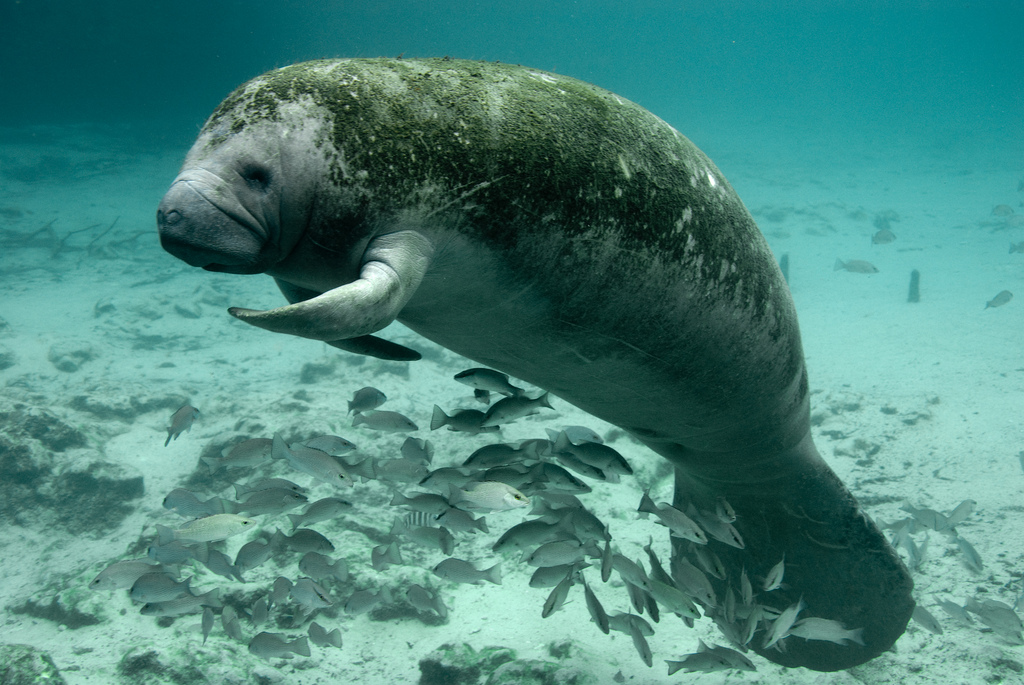Almost 1,000 manatees have died so far in 2021, and the Florida Fish and Wildlife Conservation Commission is searching for ways to put an end to the death of Florida’s gentle giants.
Currently, a research team headed by FWC’s Chip Deutsch is studying the ecosystems in the Gulf of Mexico to determine how to protect and restore them so they are optimal for manatee habitation. The team received $125,000 in funding from the National Oceanic and Atmospheric Administration RESTORE science program, which channeled money from penalties paid after the Deepwater Horizon oil spill into this research.
Manatees need to be in water that is at least 68 degrees Fahrenheit to maintain a safe internal body temperature. This means that they are attracted to warm-water springs and areas warmed by power plant thermal discharges, especially during the winter. Unfortunately, these habitats are being disturbed, and in some cases destroyed, by human activity.
The main goals of Deutsch’s team are to assess existing ecosystems, predict how these ecosystems will evolve in the future, and determine the gaps along the Gulf Coast where ecosystems need to be created or restored. These ecosystems need to be sites that can stay warm enough year round to foster manatee habitation.
“In the long term, securing a network of warm water habitats for manatees is critical, especially given that some components of the current warm water sites that manatees use are expected to decline or disappear over coming decades,” Deutsch told the Florida Political Review.
One key site Deutsch discussed lies at the head of the Faka Union Canal in Southwest Florida. In past decades, a natural thermocline formed at this site that created a warm water refuge for manatees. However, scientists noticed that temperatures in this area were cooling over time.
To preserve this area, the Florida Fish and Wildlife Services came up with a plan to create a passive thermal basin by dredging small pools and connecting them with a creek. The pools are deep enough to get input from groundwater, which warms them.
“We haven’t had a super cold winter to really test it out, but so far in mild and normal winters it seems to be creating a warm water site, and manatees are starting to find it,” said Deutsch.
Deutsch and his team are now trying to determine if this strategy is applicable along the west coast in Central Florida.
In addition to restoring warm water habitats for manatees, there has also been a discussion about allowing state and federal agencies to feed manatees, which is usually prohibited.
Manatees need 100 to 200 pounds of seagrasses and weeds each day to survive. Since they all congregate in springs and near power plants for the warm water, the food supply in these areas has been significantly diminished.
Gil McRae, director of the Florida Fish and Wildlife Services research institute in St. Petersburg, has asked lawmakers for $7 million more in 2022 to feed manatees and is considering allowing his agency to temporarily feed the sea cows.
Up to 90% of the seagrass in the Indian River Lagoon, manatees’ most important habitat, has vanished over the last decade. This is largely due to algae blooms that block sunlight and prevent more seagrass from growing.
Although manatees desperately need more access to food, state agencies are hesitant to move forward with a feeding plan out of the fear that the animals would become dependent on humans for food.
Deutsch has heard about these deliberations and was quick to clarify, “We are not asking and do not want people to feed manatees.” The FWC will still be enforcing a hefty fine and possible jail time for anyone who does take feeding into their own hands. Any feeding will be carefully controlled by professionals.
According to McRae, if lawmakers offer the funding the FWC is asking for, it will go toward restoring habitats, developing three new rehabilitation facilities, rescuing manatees, and managing the general population.
With the FWC doing their part to assist manatees, politicians have also begun to advocate for their protection. Rep. Vern Buchanan, R-Florida, is working with Mote marine scientists to introduce the Manatee Protection Act, which would move manatees back onto the endangered list. Last month, Gov. Ron DeSantis, R-Florida, announced $53 million in grants to improve water quality in the Indian River Lagoon.
Even NASA is participating. The Kennedy Space Center introduced a Health Initiative Plan to monitor the health of the Indian River Lagoon. The plan focuses on cleaning up pollution and restoring the dying seagrass beds.
All of the research and reforms in favor of preserving the lives of manatees will hopefully slow their deaths and make it possible for their population to rebound in years to come.
Check out other recent articles from Florida Political Review here.
Featured image: Unmodified photo by Keith Ramos and the U.S. Fish and Wildlife Service Headquarters used under a Creative Commons License. (https://bit.ly/3ENfSOn)






2 Comments
Hannah Burd
I love manatees! This article is incredible!
Hannah Burd
Save the manatees!